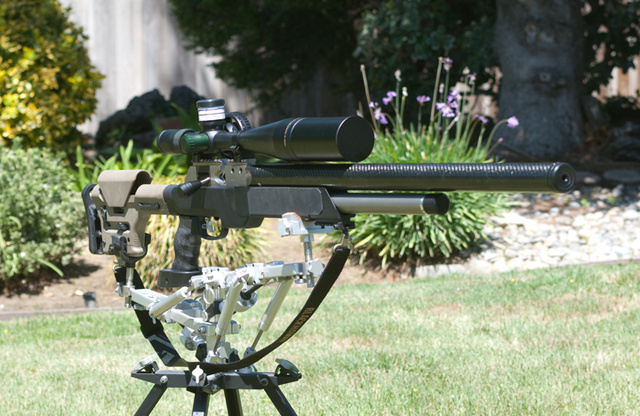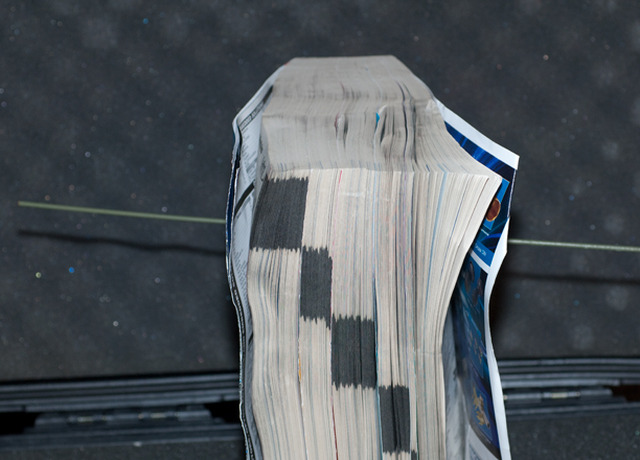I like to test the penetration of projectiles in wet paper prior to shooting animals with them. The wet paper idea came from Finn Aagard who was a shooting sports writer and former professional guide and hunter in Africa. He said that penetration in wet paper approximates penetration in muscle tissue. I use it because I enjoyed his writing growing up and it is cheap and pretty easy to do. I'll include a picture of the test block of magazines and a board which sumarizes the results. I used to use newspaper but that is getting rare these days so I now use magazines. Mostly Car and Driver and American Riflemen. They are typically 70-80 pages per magazine. I used to keep results in pages but with pretty consistent magazines I find it far easier to just count how many magazines each projectile went through, My "test standard" is a few copper plated H&N Field, Target Trophy pellets from my Prod. I've tested the Prod in dead squirrels to know if will just barely shoot through a squirrel side to side if it doesn't hit large bones. From experience I know it will also shoot through a shoulder and still get through the vitals. I like to see similar or greater penetration on projectiles I use on small game. My Prod is tuned to 17-18 fpe and FTTs do not expand so this is more penetration than I think would occur on lower fpe guns. I'm not trying to say is necessary to get to this level, just that Iike the results of this much penetration. I also know from my guns that 177s need a little less fpe to get the same penetration as 22s if both are using the same projectile.
The main reason for the tests was a retune of my P35-25. I took it from about 32 fpe to 48 fpe. So heavier pellets than I had been using are appropriate and I found a slug that shot pretty well at the new power level, Nielsen 26.8s. I shot 25 caliber Baracudas, both 33.95 JSBs, the Nielsens, the little 22 FTTs, 177 caliber knockouts and a few 22 caliber baracudas into the paper. The knockouts were 10 grain out of my P35-177. It does not shoot them well but I was interested in how they penetrate. The 22 caliber baracudas are my pellet of choice for my P35-22. I just wanted to see how they compare.
I did not get results from the 25 caliber baracudas. I was using concrete blocks to hold up the magazines (they want to slump) and the gun was not sighted for them. I hit the concrete block and they were grossly distorted and didn't penetrate well. I found them after 3, 5, and 6 magazines. The 22 caliber baracudas went through 15 magazines so obviously hitting the concrete blocks messed up the 25 caliber baracuda results. The next projectiles I found were the 10 grain 177 knockouts. They went through 8 and 9 magazines and expanded as I hope you can see. The FTTs from the Prod went through 10 magazines so the knockouts were pretty close. I would think they would work OK on squirrel sized game, rabbits and birds (if they are accurate in your gun). Two of the three Nielsen slugs expanded and those stopped after 10 magazines. The third changed to a flat shape but didn't exactly expand. It went through 12 magazines. I think these would work fine on small game but I would not take body shots on larger animals with them, I don't think they penetrate far enough. The JSB 33.95 went through 17 and 18 magazines. They would be my choice for something like a raccoon. The only one I've actually killed I shot with the P35-22 and the baracudas did fine but I think a bigger hole would work better. The 22 caliber baracudas also penetrated further than the 25 caliber Nielsen slugs.
All my results were at 25 yards except the knockouts and FTTs. I shot those point blank to place them were the bigger projectiles were not in the paper. The knockouts are so inaccurate I would probably have missed the test block from 25 yards. Separately I shot the 25 caliber projectiles at 3/4 plywood from 25 yards. All went through it. I think of this as a skull penetration test. Even the Nielsens that didn't go so far in paper went through the plywood. To me that means any of them would be OK for a reasonable sized animal brain shot. The racoon I shot with the P35-22 got one between the eyes and it put him down. Brain matter was visible in the hole. It will shoot through 1/2 but not 3/4 inch plywood. But that racoon was only 8 lbs. I think any of these 25 caliber projectiles should go through the skull of even a large raccoon or a fox or a coyote. The domed pellets should penetrate the body to vitals but a 25 caliber hole may not put them down quickly.
I hope these results are helpful or at least somewhat interesting.


The main reason for the tests was a retune of my P35-25. I took it from about 32 fpe to 48 fpe. So heavier pellets than I had been using are appropriate and I found a slug that shot pretty well at the new power level, Nielsen 26.8s. I shot 25 caliber Baracudas, both 33.95 JSBs, the Nielsens, the little 22 FTTs, 177 caliber knockouts and a few 22 caliber baracudas into the paper. The knockouts were 10 grain out of my P35-177. It does not shoot them well but I was interested in how they penetrate. The 22 caliber baracudas are my pellet of choice for my P35-22. I just wanted to see how they compare.
I did not get results from the 25 caliber baracudas. I was using concrete blocks to hold up the magazines (they want to slump) and the gun was not sighted for them. I hit the concrete block and they were grossly distorted and didn't penetrate well. I found them after 3, 5, and 6 magazines. The 22 caliber baracudas went through 15 magazines so obviously hitting the concrete blocks messed up the 25 caliber baracuda results. The next projectiles I found were the 10 grain 177 knockouts. They went through 8 and 9 magazines and expanded as I hope you can see. The FTTs from the Prod went through 10 magazines so the knockouts were pretty close. I would think they would work OK on squirrel sized game, rabbits and birds (if they are accurate in your gun). Two of the three Nielsen slugs expanded and those stopped after 10 magazines. The third changed to a flat shape but didn't exactly expand. It went through 12 magazines. I think these would work fine on small game but I would not take body shots on larger animals with them, I don't think they penetrate far enough. The JSB 33.95 went through 17 and 18 magazines. They would be my choice for something like a raccoon. The only one I've actually killed I shot with the P35-22 and the baracudas did fine but I think a bigger hole would work better. The 22 caliber baracudas also penetrated further than the 25 caliber Nielsen slugs.
All my results were at 25 yards except the knockouts and FTTs. I shot those point blank to place them were the bigger projectiles were not in the paper. The knockouts are so inaccurate I would probably have missed the test block from 25 yards. Separately I shot the 25 caliber projectiles at 3/4 plywood from 25 yards. All went through it. I think of this as a skull penetration test. Even the Nielsens that didn't go so far in paper went through the plywood. To me that means any of them would be OK for a reasonable sized animal brain shot. The racoon I shot with the P35-22 got one between the eyes and it put him down. Brain matter was visible in the hole. It will shoot through 1/2 but not 3/4 inch plywood. But that racoon was only 8 lbs. I think any of these 25 caliber projectiles should go through the skull of even a large raccoon or a fox or a coyote. The domed pellets should penetrate the body to vitals but a 25 caliber hole may not put them down quickly.
I hope these results are helpful or at least somewhat interesting.

